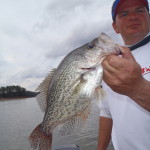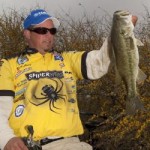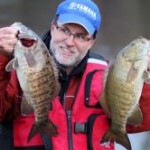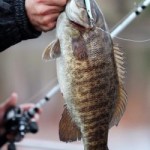Many crappie fishermen are getting tackle ready, planning and looking forward to March when the slabs start to move into the shallows to spawn, but they are making a mistake. If you aren’t fishing for crappie in February you are missing out on some of the best fishing of the year, especially for big fish.
Clark’s Hill is our biggest lake and offers great crappie fishing. There are many creeks and smaller rivers entering the lake that run in different directions, so you can find a place to fish that does not get the brunt of the winter wind. And you can find just about any water clarity you want to fish.

two big crappie
Rod Wall grew up and still lives near the lake in 96 South Carolina. He has a place on the South Carolina Little River arm of the lake and builds docks and seawalls on Lake Greenwood and Clark’s Hill. All his life he has been fishing Clark’s Hill for crappie.
About six years ago Rod started fishing crappie tournaments. He set small goals, first trying to catch a limit in each tournament, then to place and now to win. He does well on the Crappiemasters, Crappie USA and Georgia Slabmasters trails. He guides for crappie on both Lake Greenwood and Clark’s Hill.
Rod has done well enough on the trails to be sponsored by B ‘n M crappie rods, Vicious Line, and Hummingbird Electronics. He likes Southern Pro jigs and Midsouth Tackle jigs and trailers for his fishing and carries about 400 color combinations of jig heads and trailers with him in his boat.
Rod’s usual partner in tournaments is his 15 year old son Braxton and he has learned well. He has won two youth national championships, the 2010 Crappie USA Pickwick tournament and the 2011 Crappiemasters Alabama River tournament.

Nice winter crappie
“You can catch some of the biggest crappie of the year right now,” Rod told me. The fish are moving into the creeks toward spawning areas and are feeding actively. There are several ways to catch them that work from right now through March.
To prove his point, he took me fishing in mid-January and we landed about ten crappie. The biggest seven went from 1.40 to 1.91 pounds – on his tournament scales. Those are big crappie. But he catches even bigger. His best seven fish

Winter crappie
tournament limit weighed 17.5 pounds and he has landed three pound crappie on Clarks Hill this time of year.
Rod likes to longline, also called pulling or trolling, for crappie. His Lund boat is set up with Driftmaster rod holders allowing him to fish 14 B n M rods out the back. This setup lets him cover a lot of water quickly, finding the schools of fish and catching them.
To start the day Rod will look for stained water since he says crappie hit better on a reaction bite when the fish can’t get as good a look at the bait. He will watch his depthfinder for baitfish and schools of crappie to determine the depth he wants to run his jigs and use either four or six pound test Vicious line and vary the weight of jig heads to keep them at that depth.
“One of the biggest mistakes a beginner crappie troller makes is to not know the depth he is fishing,” Rod says. The best way to learn is to put out some one sixteenths ounce jigs and troll them over a flat of a consistent depth. Vary the speed of your boat until the jigs start to bump the bottom. If it is 12 feet deep that will tell you that size jig will run at that depth at the set speed.
Speed and line size is as critical as the size of the jig. The length behind the boat you troll is also important. Rod has made a chart so he knows exactly how fast to troll a jig size and line size combination to fish a set depth.
Normal trolling speed is from .6 to 1.2 MPH. A good GPS will tell you exactly how fast you are trolling and Rod keeps a constant eye on his speed. His boat is rigged with a Minkota remote control trolling motor and he can work it from the back of the boat near the rods to keep his boat on an exact course and speed.
Crappie relate to the channels as they move toward the spawning areas so he starts near the channel, fishing points and flats along them. We caught most of our fish in January off the end of a big flat that ran out to the Little River channel and dropped off on one end into a small feeder creek. They were stacked up on the drop.
Another mistake beginners make is to try to start with too many rods. Although Rod uses 14 B ‘N Rod rigs, you should start with just six to eight rods until you learn to control them and not get tangled.
It is also important to keep your rod tips down at the surface of the water, especially if there is any wind. Wind will catch the line and make it change depths and speeds, making control difficult if the rod tip is up off the water.
On his boat Rod will have four eight foot B ‘n N rods across the back beside the motor. Three more rod holders on each side have a 12, then 14 and finally a 16 foot rod. This allows you to cover 32 feet plus the width of the boat on each troll, a swath almost 40 feet wide.
In more clear water or if you want to run your jigs deeper, use four pound test line. In stained water or if you want to keep your jigs higher you can use six pound test line. First thing in the morning Rod will try several different colors but will switch most of his jigs to the color the crappie prefer.
Rod warns that the color choice can change rapidly during the day so if the fish slow down hitting one color try others. Also vary your speed if the bite slows on one that has been working. Watch your depthfinder so you stay at the depth the fish are holding and keep your bait there by changing jig size or line size for the speed you need to go.
A loop knot used to attach your jig head to the line definitely gives it more action and Rod always ties them on that way. With the light line a good know is critical. You need to tie one that will not cut the light line.
Some of Rod’s favorite places to fish on Clark’s Hill are the South Carolina Little River arm above the Highway 378 Bridge, Soap Creek above the Highway 220 Bridge, Haw and Wells Creeks on the Savannah River arm and Germany, Rousseau and Kemp Creeks on the Georgia Little River arm. He also fishes up Big Hart Creek and Little River around Kemp Creek.
Start toward the backs of these creeks in the mornings in February and pull out toward the mouth until you find the fish. On Clark’s Hill you can find space away from other boats giving you room to troll and make the wide turns necessary to be successful. Once you find an area holding crappie, either when you start catching them or seeing a lot of bait and crappie on your depthfinder, stay in that area.
Rod likes curly tail jigs and will tip them with a live minnow to see if that helps. He often puts jigs out on one side with minnows and jigs without minnows on the other side of the boat to see what the fish prefer. If they are hitting the jigs without minnows there is no need to use them.
Crappie often are just barely hooked on the jig so you should not set the hook or fight them too fast. Just pick up the rod and start reeling. Keep the fish in the lane that rod is in so they don’t tangle other lines and let them run when they want to. You have to keep the boat moving so reel very slowly.
You will need a long handle net for bigger fish. Rod says you should never get the fish closer to the boat than the length of line equal to the rod length. When the fish is about a rod lengths line away, slowly lift your rod tip to bring it to the net.
No matter how tempting it is to try to land a big striper, hybrid or largemouth when you hook one, they will make a mess of all your lines. In tournaments Rod will instantly break them off. The day we fished he hooked a nice striper and tried to land it. It tangled 12 of our 14 lines. If you want to try to land a big fish be prepared to untangle lines. Jut be sure it is not a really big crappie before you break it off!
Another trick when trying to find out exactly what the fish want is to run a zigzag pattern with your boat. That will speed up jigs on one side and slow them down on the other. This not only changes speed, it will change depth, so you can find out what they want.
On sunny days Rod will use translucent jigs and more colorful jigs on cloudy days. A little breeze often helps but stronger wind makes boat control difficult. To control his speed when trolling with the wind Rod keeps a drift sock in his boat and puts it out to slow him down. He will also put his motor in gear and he says that will slow your speed up to a tenth of a mile and hour by itself.
Some current definitely positions the fish deeper on cover so it makes trolling more difficult. No mater what, make sure your jigs stay clean. Any small piece of grass or other trash on the jig will guarantee the fish won’t hit it.
Don’t hesitate to change speed, color and depth when you are not catching anything. As Rod says, if you aren’t catching any fish it certainly doesn’t hurt to change.
The trolling season for crappie extends a long time. Warming water even for a few days can turn the fish on and anytime the water is over 50 degrees the fishing is good. There are both black and white crappie in Clark’s Hill and the blacks move in earlier, followed a couple of weeks later by the whites, so that extends the good fishing time.
Rod says black crappie will spawn at 60 degree water temperature and whites a couple of weeks later, so keep up with the water temperature. Fish move in waves of schools so you can keep up with them and catch them over a longer time than you might expect.
Smaller fish are often more aggressive and hit more shallow, so drop your jigs a little deeper if you are catching small fish but seeing others a little deeper. But be sure to always keep your jigs above the fish. Rod says crappie will sometimes come up six feet to hit a jig but will never go down to take one.
There are other ways to catch crappie this time of year. Rod has rod holders on the front of his boat for pushing bush piles and standing timber. This method involves putting the rods out in front of the boat, moving up close to the brush or tree, and letting the jigs or minnows drop straight down.
Depth is critical when pushing, too, so try different depths until you find what they want. Standing trees in the mouths of spawning creeks and pockets often hold large numbers of crappie and you can catch a lot while pushing them.
Clark’s Hill used to be known for its crappie fishing during the spawn in the button or buck bushes but the lake has been low for so long that has not happened in years. Fish will spawn just about anywhere along the bank and even out in deeper water on brush and standing timber.
The lake was 16 feet low the day we fished, just before all the rain in the middle of the month. The lake had come up about a foot since Christmas and should still be rising. The rain will give more color to the creeks and that should improve the trolling.
Rod’s depthfinder has a barometer indicator on it and he likes to see a rising or falling barometric pressure. He says a steady barometer is not good but movement in either direction will help make the bite better. An approaching front, with changing pressure, definitely helps.
If you want to catch some big crappie, head to Clark’s Hill this month. Try Rod’s methods or fish the way you like best. There are other good creeks on the lake, too so don’t get stuck on one pattern on place.
To book a guide trip with Rod on Greenwood or Clark’s Hill call him at 864-993-8868 or visit his web sites at http://slabmasterguideservice.com for more information and to book a trip.






